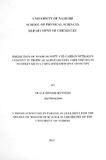Prediction of wood density and carbon-nitrogen content in tropical agroforestry tree species in Western Kenya using infrared spectroscopy
Abstract
The global debate on climate change needs to be furnished with accurate and precise
measurement of biomass in agricultural landscapes. Wood density is a supporting
parameter for biomass estimation; however, empirical methods for wood density
determination are destructive and complex, as are conventional wet chemistry analyses
of carbon and nitrogen. Thus a low cost and non-destructive method of estimation is
required. Infrared Spectroscopy coupled with chemometrics multivariate techniques
offers a fast and non-destructive alternative for obtaining reliable results without
complex sample pre-treatments. This study sought to develop a prediction model for
estimation of wood density, carbon and nitrogen across species using Infrared
Spectroscopy.
Empirical data for determination of these parameters were obtained from coring 77 trees
sampled from three benchmark sites (Lower, Middle and Upper Yala blocks) along Yala
basin in Western Kenya. Samples from cored holes in the tree (branch, stem and roots)
were used to estimate wood biovolume and density. Models for estimation of these
parameters were derived from scanning 404 cores using diffuse reflectance Infrared
Spectroscopy and reference values for carbon and nitrogen obtained using a CarbonNitrogen
analyzer. Partial least squares regression, using first derivative spectra pretreatment,
was used to develop a model based on different calibrations sets. Models were
compared on the basis of the accuracy of prediction using the coefficient of
determination (R2), Standard Error of Calibration (SEC) and Standard Error of Prediction
(SEP)
Citation
Masters of science in ChemistryPublisher
University of Nairobi Chemistry
Subject
wood densitycarbon-nitrogen content
tropical agroforestry tree species
Western Kenya
infrared spectroscopy

